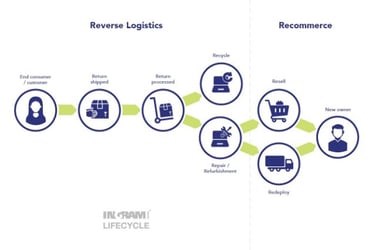Demand for refurbished smartphones is growing. As such, you may want to offer these as a solution for your customers, either through ownership or leasing. You’ll need to source these devices and understand device grading systems.
Alternatively, you may be considering offering a trade-in solution for your customers so you'll need to utilize a grading system to assess the quality and functionality of devices to find out their value.
Whether sourcing or selling refurbished devices, you need to understand grading systems to help inform the value for money.
Ingram Micro Lifecycle sources preloved smartphones from a variety of channels. One source is the management of trade-in programs for leading network providers and OEMS (Original Equipment Manufacturers). One of the services available for these customers is the repair and refurbishment of such devices, which follows grading to uplift the grade and, in turn, the value.
We demystify the different device grades below and what this means for maximizing value recovery and return.
Why are refurbished devices graded?
Each device received needs to undergo an assessment against a specific list of criteria. The outcome of this directly impacts the value of the device. It informs what repairs and refurbishments are required to improve the grade. This is important if the device is heading to secondary markets and the maximum value needs to be recovered in a cost-efficient manner.
When listed for sale, the grade is a guideline for potential buyers of the quality of the device, whether it meets their needs, and what they may need to do to make a profit on their purchase.
The process of grading the device opens the door for repairs and refurbishment, kickstarting a circular economy by extending the lifecycle of devices and reducing the likelihood of the device going to e-waste.
The different grades of devices
This is not a definitive guide as the exact criteria will vary from company to company, but this is a typical expectation of the grading system.
A grade
The highest quality preloved devices, A grades are like new or similar, carrying no visible damage or wear.
You’d struggle to distinguish these from brand-new devices based on looks and function alone.
B grade
Slightly lower condition than A-grade devices, B grades may retain some visible wear, such as scuffs and light scratches, which don’t affect the usability.
The functionality is still good and like that of A-grade devices.
C grade
These are the lowest quality used devices available on the market.
These will show signs of previous life, such as dents and more noticeable scratches.
D grade
Secondhand devices graded D are non-functioning devices and need a degree of repair to restore operations.
These repairs are required to make the device more saleable.
Lower grades
These are beyond economical repair. The lifecycle of these devices cannot be cost-effectively extended.
The device will be stripped down to salvage any useful parts that could be used as donor parts to enable the lifecycle extension of another similar device.
The rest, waste, should be responsibly recycled where possible.
The grading process
Various technologies determine the quality and function of the device components and outputs to determine the grade. These assessments include:
- Camera
- Audio
- Microphone
- Accelerometer
- Wifi
- LCD
- Cosmetics
- Battery life
- And more
As the technology behind our phones advances, so too do the internal mechanics that help fault-finding. This built-in technology assists operatives in following best practices for device testing. For example, in screen and camera calibration as well as audio functionality.
To simplify the process, set questions require yes/no answers only. This system-driven approach limits the subjectivity of the technician processing the device. The automation guarantees consistency from device to device and that the full process is adhered to.
Following grading, the devices are routed away based on the channel they came from and the assessment outcome.
Holding an OEM accreditation provides the partner with access to approved processes and software to accurately conduct data wiping, software updates, and more.
This level of interrogation into the usefulness of the device enables appropriate action to be taken to restore the device, where possible. This insight typically saves it from the landfill where it becomes harmful e-waste.
How to improve device grades
There are technical repair and refurbishment processes that uplift a device’s grade, both invasive and cosmetic. Invasive solutions get under the shell of the device, working on improving internal componentry. Cosmetic processes improve how the device looks, working away scuffs and scratches.
Invasive processes can use donor parts, typically taken from grade D devices and brand-new parts. A solutions partner with OEM accreditations will have access to their genuine parts. This accreditation signals that the partner follows the manufacturer-approved procedures, has access to repair manuals and instructions, and is deemed reliable by the manufacturer.
Diamond Substrate Processing
This is one example of a cosmetic process. Developed by Ingram Micro Lifecycle, this removes the very top layer of a screen, the oleophobic coating, that’s subjected to minor scuffs and scratches. This is then carefully replaced, removing any sign of the previous damage.
LCD repair
Replacing the LCD screen of a smartphone can be expensive.
Using a combination of technologies, it’s possible to isolate and replace the outer layers that are more prone to damage.
Battery replacement
This is a highly common repair. Over time, a battery loses its ability to hold a charge.
The older the battery, the less power the battery cell will be able to provide.
Understanding device grading
As we mentioned, grading categories can vary between companies, but generally, these same top-level standards apply. Grade A devices are the highest quality and are considered like-new. The quality decreases down to grade C. These have some working components but some repairs are needed to be considered fully functional.
Through this grading process, the quality of the device is labeled to determine its value and the requirements to extend its lifecycle, enabling a circular economy.
Over the years, Ingram Micro Lifecycle has developed stringent processes, aided by accreditations by the majority of global OEMs, to accurately assess devices for grading. We work alongside large network operators to manage trade-in programs to either return the used devices to their stock or repair and refurbish them ahead of reuse. We also work with insurers to assess and grade devices via insurance claims.
In 2022, we assisted one of the major operators within the UK with their recycling program which saved 250,000 devices from landfill.
Reach out to our team today to discuss the sourcing of preloved devices or how we can support your management of traded-in handsets.
Related articles:
- Issues and challenges within the refurbished technology market
- Switching supply from new to refurbished devices? 5 key questions
- How quickly do smartphone returns depreciate? 5 key factors
- 5 sourcing pitfalls to avoid when stocking refurbished electronics
- Attractors and detractors of refurbished products for consumers
- How to repair damaged smartphone screens: smashed & delaminated screens








.jpg)




